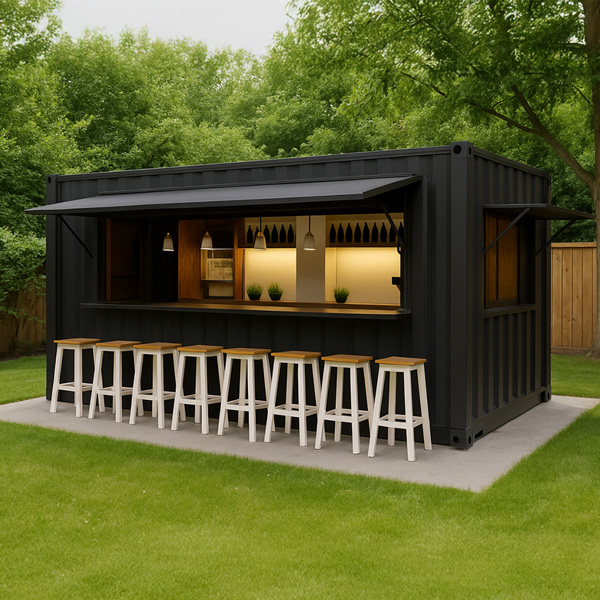March 25th, 2025 • Intermodal Containers
Beyond Shipping: Unconventional Uses for Intermodal Containers
Intermodal containers, commonly known as shipping containers, are the backbone of global trade and logistics. These sturdy, reusable metal boxes facilitate the transportation of goods across the globe, connecting supply chains and economies. However, their sheer durability and versatility have enabled them to transcend their shipping origins, sparking creative innovations across numerous industries. You might think of intermodal containers purely as tools for transportation, but their potential goes far beyond maritime routes and railroads.
Today, we’re exploring the surprising and unconventional uses for these containers, from homes and businesses to art installations and agricultural solutions. If you're in the shipping, storage, or construction industry—or simply someone curious about sustainable innovations—this post will spark your imagination.

Repurposing for Living Spaces
Shipping containers may not seem like the obvious choice for homes, but they have become a global phenomenon in modern architecture. Architects and designers have turned these industrial steel boxes into fully functional, aesthetic living spaces that often rival traditional homes. Known colloquially as "container homes," these dwellings range from minimalistic single-container designs to multi-container mansions.
Examples from Around the World
- "The Joshua Tree Residence" in California, USA, combines several containers into a luxurious modern retreat. With wide windows and seamless interiors, it challenges the notion of what’s possible in container architecture.
- "Wolveridge Architects' Projects in Australia" are prime examples of energy-efficient, sustainable designs that blend with their natural surroundings.
- Container Villages in Kenya house affordable, compact urban apartments, addressing housing shortages in high-density cities like Nairobi.
Benefits of Container Homes
- Sustainability: By repurposing used containers, these homes reduce waste and support eco-friendly living. They also use fewer raw materials compared to traditional construction methods.
- Cost-Effectiveness: The affordability of containers makes them appealing, especially for budget-conscious homeowners. The ability to scale up or down based on your budget creates flexibility.
- Mobility and Versatility: Some container homes can be disassembled or even relocated, making them ideal for individuals seeking flexibility.
Innovative Business Spaces
Outside of residential settings, shipping containers have been making waves in commercial spaces. Their portability, modular nature, and cost efficiency have enabled businesses to think outside the box—literally.
Examples of Business Uses
- Pop-up Shops and Restaurants: Global brands such as Nike and Starbucks have utilized containers for pop-up experiences in urban settings, generating buzz and drawing in customers. The famous Smorgasburg Food Market in Brooklyn, New York, has seen restaurants crafted from containers, offering functional yet appealing designs for both chefs and patrons.
- Modular Office Spaces: Urban office spaces made from intermodal containers are appearing in cities with high property costs. Companies save on overhead and gain the flexibility to expand or relocate.
Benefits for Businesses
- Cost Savings: Containers are considerably cheaper than constructing a brick-and-mortar building.
- Flexibility: Ideal for startups or businesses hosting events, containers provide temporary yet fully customizable spaces.
- Quick Installation: Unlike traditional construction, container structures can be assembled in weeks instead of months.

Art and Culture
Shipping containers aren’t just functional; they’re becoming iconic in the art, culture, and creative spaces. Their blank, industrial surfaces make them an ideal canvas for imaginative projects.
Artistic Applications
- Art Installations and Exhibitions: Designers and artists often use containers for urban art installations. For example, the "Cargo Library" in Seoul transforms a single container into a cultural hub filled with art, literature, and history.
- Mobile Museums and Galleries: "Nomadic Museum", pioneered by artist Gregory Colbert, uses containers to create a traveling museum featuring his powerful photo exhibitions. Pop-up galleries in London and Paris are showcasing emerging artists by offering short-term exhibitions.
- Community Art Projects: Containers repurposed as street canvases have brightened neighborhoods and sparked creativity in local communities around the globe.
Importance to Culture
Art made from shipping containers symbolizes industrial transformation and underlines the importance of sustainability in cultural expression.

Agricultural Applications
Agriculture is turning vertical, and shipping containers are playing a central role in this revolution. Repurposed containers are fostering new methods of urban farming. Vertical and Urban Farming
- How It Works:
- Companies like Freight Farms and Square Roots are utilizing containers to create climate-controlled environments for hydroponic farming.
- Inside these containers, crops such as lettuce, spinach, and herbs are stacked vertically, optimizing space and minimizing water usage.
- Case Studies:
- A startup in Boston transformed containers into mobile farms that feed local communities year-round.
- Cities like Singapore—where land space is scarce—are using container farms to grow food locally and sustainably.
Environmental Impact
Vertical farming requires significantly less land and water compared to traditional farming. Its mobility also ensures fresh produce can reach urban populations quickly, reducing carbon footprints tied to transportation.

Disaster Relief and Emergency Shelters
Shipping containers come to the rescue when disasters strike, providing quick, durable solutions for emergency shelters in impacted regions.
Real-World Applications
- Relief Efforts:
- After the 2010 earthquake in Haiti, containers were converted into sturdy shelters for displaced families.
- Similar approaches were taken during humanitarian crises in conflict zones such as Syria.
- Mobile Medical Units:
- Containers are also turned into mobile clinics for healthcare delivery in regions with limited access to facilities.
Advantages
- Speed of Deployment: Shipping containers are readily available and can be rapidly transported to disaster regions.
- Durability: Designed for harsh conditions, containers provide reliable shelter against extreme weather.
- Capacity: They can be outfitted with kitchenettes, bathrooms, and sleeping quarters to provide complete, functional units.
Inspire Creativity and Sustainability with Shipping Containers
Intermodal shipping containers prove there’s more to them than meets the eye. Beyond their traditional use in transportation, they are revolutionizing industries, inspiring creativity, and contributing to sustainable practices. From homes and offices to art and agriculture, their applications are far-reaching and impactful.
If you’re curious to explore these innovative uses for containers—or even invest in one—our team can guide you. With a transparent, hassle-free procurement process, Container Chiq ensures you find the right container for your needs, whether you're building a home, starting a café, or contributing to a community project. Reach out to us today to learn more!
